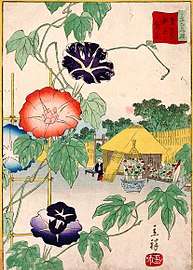Ipomoea nil
Ipomoea nil is a species of Ipomoea morning glory known by several common names, including picotee morning glory, ivy morning glory, and Japanese morning glory. It is native to most of the tropical world, and has been introduced widely.
| Ipomoea nil | |
|---|---|
 | |
| Scientific classification | |
| Kingdom: | Plantae |
| Clade: | Tracheophytes |
| Clade: | Angiosperms |
| Clade: | Eudicots |
| Clade: | Asterids |
| Order: | Solanales |
| Family: | Convolvulaceae |
| Genus: | Ipomoea |
| Species: | I. nil |
| Binomial name | |
| Ipomoea nil | |
| Synonyms | |
| |
Description

Native to Central America and Mexico, the plant is a climber with twining stems up to 5 m long and is densely to scattered with long hairy trichomes. The finely hairy, emerald green leaves are ovate to almost circular, 5 to 14 cm long. The base is heart-shaped, the edge is entire or lobed three to five times, the leaf lobes are pointed or tapering.
The funnel-shaped, colorful flowers (blue to reddish purple, with whitish tube) are quite showy and are individually up to five in often dense cymose groups, in which fully developed flowers and developing buds stand together. They open in the morning and close by the afternoon. The long, thorny hairy sepals have a length of 15 to 25 mm, they are long lanceolate and have a linear-lanceolate tip. The crown is blue, purple or almost scarlet red. The throat is often colored white. The crown tube has a length of 3 to 5 cm, the crown hem has a width of 4 to 5 cm.
The fruits are almost spherical to spherical capsule fruits with a diameter of 8 to 12 mm. The seeds are pear-shaped and densely covered with short trichomes.
Cultivation
It is cultivated as an ornamental plant in many places, and the descendants of garden escapees now grow wild. Fast-growing and self-seeding, it may used to hide unsightly fences or walls, and may also be used decoratively on trellises. This is a climbing annual herb with three-pointed leaves 3 to 8 centimeters long. The flowers are several centimeters wide and appear in various shades of blue, pink or rose, often with white stripes or edges or blends of colors. Common cultivars include 'Scarlet O'Hara', 'Early Call', and 'Rose Silk'. [1][2]
Hybrids, for instance with I. purpurea, have been developed. Some of these have been given the name I. x imperialis (Imperial Japanese morning glory), which is not official. Cultivars include 'Sunrise Serenade'. Alternative nomenclatures include Ipomoea nil x imperialis, as in 'Cameo Elegance', or Ipomoea nil' 'Imperialis'. [3]
Morning glories in Japan
Morning glories are popular in Japan. They are believed to have been introduced there directly from China in the Heian period of the 8th to 9th centuries. During the Edo period of the 17th to 19th centuries, as more people started to live in cities, a fad for growing potted morning glories of different colors and sizes swept through the country. The pots are often equipped with cylindrical structures called andon shitate (Japanese: 行燈仕立て), which look like Japanese lanterns at night.[4]
In early summer, morning glory markets are held in large cities in Japan, where merchants and hobbyists sell the flowers. The largest of such markets is the Iriya Morning Glory Market (Japanese: 入谷朝顔市, July 6–8), held along the roads surrounding Shingenji Temple, commonly called "Iriya Kishibojin", in Iriya, Taito-ku, Tokyo.[5]
Gallery
 "Morning Glories in Iriya, Eastern Capital" (1866), No 28 of "The Thirty-six Selected Flower Scenes" by Hiroshige II
"Morning Glories in Iriya, Eastern Capital" (1866), No 28 of "The Thirty-six Selected Flower Scenes" by Hiroshige II- The Iriya Morning Glory Market, Tokyo (2008)
 Scarlett O'Hara cultivar
Scarlett O'Hara cultivar
See also
References
- "Morning Glory Scarlet O'Hara". The National Gardening Association. Retrieved 2009-01-15.
- Halpin, Anne (2007-05-01). "TWINERS: Morning glories, moonflowers, and their relatives". Horticulture magazine. Retrieved 2009-01-15.
- "NaturalPedia". Archived from the original on 2011-07-14. Retrieved 2011-03-17.
- Iriya Asagao Matsuri (Morning Glory Festival) (Go Tokyo)
- All About Iriya Asagao (Morning Glory) Market/Festival: how to get to, schedule & souvenirs (Tokyo Direct Diary)
External links


- Jepson Manual Treatment
- Aluka Species Profile
- HEAR Species Profile